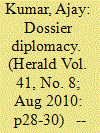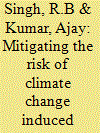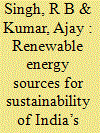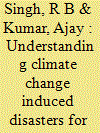|
|
|
Sort Order |
|
|
|
Items / Page
|
|
|
|
|
|
|
| Srl | Item |
| 1 |
ID:
097973


|
|
|
| 2 |
ID:
132487


|
|
|
|
|
| Publication |
2014.
|
| Summary/Abstract |
The world's climate is continuing to change at rates that are projected to be unprecedented in recent human history. The risks of climate change and extreme climatic events such as drought and ?ood have dramatic impacts on economy and natural systems. Agriculture, livestock and water resources are among the most vulnerable systems. Resilience and adaptive capacity of traditional networks and land use systems to cope with climate variability/extremes are weakening, while ' frequency and magnitude of climate variability and land use intensity are in rise. Thus it is important to take timely action in order to reduce the risk of climate change.
|
|
|
|
|
|
|
|
|
|
|
|
|
|
|
|
| 3 |
ID:
138381


|
|
|
|
|
| Summary/Abstract |
The domestic production of crude oil from fossil fuels remains more or less stagnant over the years and meets only one third of national requirement, while the balance is met through imports of crude petroleum products that cost huge for the country close to $90 billion in 2008-09, which have massive impact on the country’s foreign exchange reserves.
|
|
|
|
|
|
|
|
|
|
|
|
|
|
|
|
| 4 |
ID:
130766


|
|
|
|
|
| Publication |
2013.
|
| Summary/Abstract |
The advancement in infrared (IR) detector technologies from 1st to 3rd generation and beyond has resulted in the improvement of infrared imaging systems due to availability of IR detectors with large number of pixels, smaller pitch, higher sensitivity and large F-number. However, it also results in several problems and most serious of them is sensor non-uniformities, which are mainly attributed to the difference in the photo-response of each detector in the infrared focal plane array. These spatial and temporal non-uniformities result in a slowly varying pattern on the image usually called as fixed pattern noise and results in the degradation the temperature resolving capabilities of thermal imaging system considerably. This paper describes two types of non uniformity correction methodologies. First type of algorithms deals with correction of sensor non-uniformities based upon the calibration method. Second type of algorithm deals with correction of sensor non uniformities using scene information present in the acquired images. The proposed algorithms correct both additive and multiplicative non uniformities. These algorithms are evaluated using the simulated & actual infrared data and results of implementations are presented. Furthermore, proposed algorithms are implemented in field programmable gate array based embedded hardware.
|
|
|
|
|
|
|
|
|
|
|
|
|
|
|
|
| 5 |
ID:
141237


|
|
|
|
|
| Summary/Abstract |
The global climate is changing at rates that are unprecedented in recent human history and faster than the ability of natural system to adapt. Climate change is increasingly recognized as a critical challenge to ecological health, human well-being, livelihood security and future development (Singh and Heitala, 2014), as understood by the award of the Nobel Peace Prize for 2007 to the Intergovernmental Panel on Climate Change (IPCC) (Leary et al., 2008). The risks of climate change and extreme events such as drought and flood have substantial impacts on economy and natural systems. Agriculture, livestock and water resources are among the most vulnerable systems. According to Sen Roy and Singh, 2002, changing climate elements and their extremes will significantly alter productivity in agriculture and forest ecosystem, which in turn will affect the socio-economic conditions of many societies. Climate change is expected to increase the frequency and intensity of current hazards and the probability of extreme events, and also to spur the emergence of new hazards (Nicholls and Lowe, 2006). Extreme events within the variability of the climate system are, by far, the largest cause of natural disasters worldwide each year (Kininmonth, 2004). Therefore, resilience and adaptive capacity of traditional networks and land use systems to cope with climate variability/extremes are weakening, while frequency and magnitude of climate variability and land use intensity are in rise. Thus, it is important to understand the phenomenon of climate change and associated vulnerability of different sectors, regions and people.
|
|
|
|
|
|
|
|
|
|
|
|
|
|
|
|
|
|
|
|
|